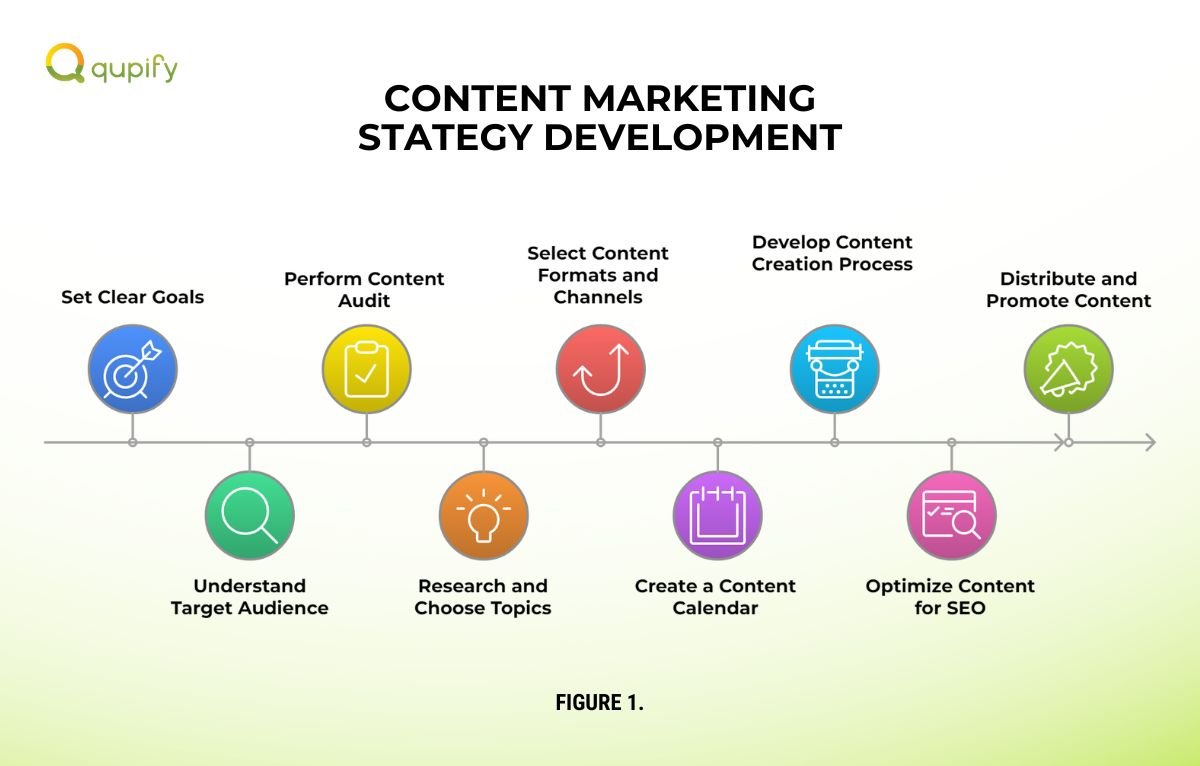How to Develop a Content Marketing Strategy
Creating a content marketing strategy can feel overwhelming, but it’s all about having a clear plan. This strategy is your guide to making and sharing content that helps your business grow. It focuses on reaching the right audience, keeping them engaged, and encouraging them to take action, like buying a product or signing up for a service.
A good strategy builds trust with your audience and shows that your business understands their needs. By staying consistent and using data to make decisions, your content can stand out and bring long-term success. Let’s explore the steps to create your content marketing strategy.

Step 1: Set Clear Goals
The first step in any strategy is knowing what you want to achieve. Are you trying to get more website visitors, increase social media followers, or boost sales? Your goals should follow the SMART method: Specific, Measurable, Achievable, Relevant, and Time-bound.
For example, instead of saying, “I want more website traffic,” aim for, “I want to increase my website traffic by 20% in three months.” Clear goals keep you focused and help you track progress.
Step 2: Understand Your Target Audience
To create content that works, you need to know your audience. Who are they? What are their problems? What kind of content do they enjoy?
Start by building a buyer persona, which is a detailed description of your ideal customer. Look at their age, job, interests, and online habits. This information helps you create content that speaks directly to them and solves their problems.
Step 3: Perform a Content Audit
If you already have some content, it’s time to take a closer look. Check what you’ve done so far—blogs, videos, or social media posts—and see what worked and what didn’t. Look at metrics like views, shares, or sales leads.
Organize your content into categories and find gaps where you can add something fresh. For example, if you’ve been posting blogs but no videos, it might be time to try video content.
Step 4: Research and Choose Content Topics
Once you understand your audience and know what’s missing, it’s time to pick the right topics. Use tools like Google Trends or keyword research tools to find out what people are searching for in your industry.
Study competitors to see what topics they’re covering and think about how you can add your own spin. Your goal is to create valuable, unique content that stands out.
Step 5: Select Content Formats and Channels
Content comes in many forms—blogs, videos, podcasts, infographics, and more. Choose formats that fit your goals and appeal to your audience. For instance, if your audience loves watching short videos on Instagram, focus on that. Also, pick the platforms where your audience is most active, like Facebook, LinkedIn, or YouTube.
Step 6: Create a Content Calendar
A content calendar helps you stay organized and consistent. Plan out what content you’ll create, when it will be published, and on which platforms. Use the calendar to include seasonal trends or events that matter to your audience. For example, if you sell gifts, focus on Valentine’s Day or Christmas. Consistency is key—posting regularly keeps your audience engaged.
Discover simple steps to engage your audience, boost traffic, and achieve business goals here.
Step 7: Develop a Content Creation Process
Producing content takes teamwork. Assign roles for writing, editing, and publishing. If you don’t have a large team, consider outsourcing some tasks. Create templates and guidelines to make sure your content matches your brand’s voice and style. This saves time and ensures your content looks professional.
Step 8: Optimize Content for Search Engines
SEO, or search engine optimization, helps your content appear higher in search results. Use relevant keywords, write clear meta descriptions, and include internal links to other pages on your website. Also, make sure your content loads quickly and looks great on mobile devices. Don’t forget to update older content to keep it fresh.
Step 9: Distribute and Promote Your Content
Even the best content needs a push to reach people. Share it on social media, send it through email newsletters, or partner with other brands to get the word out. Paid ads can also help promote your top-performing content. The more people see your content, the better chance you have of achieving your goals.
If you want to learn more about creating a winning content marketing strategy, click here.
Step 10: Measure and Analyze Performance
Once your content is live, track how it performs. Use tools like Google Analytics or social media insights to see what’s working. Are people clicking on your links? Are they spending time reading your blog? Use this data to improve your strategy. If something isn’t working, adjust it and try again.

Conclusion
A content marketing strategy is all about planning and adapting. Start by setting clear goals and understanding your audience. Use that knowledge to create and share content that adds value to their lives. Remember, success doesn’t happen overnight, but with a solid plan, you can build a strategy that works for the long term. Now it’s your turn—take the first step and start creating your content strategy today!



